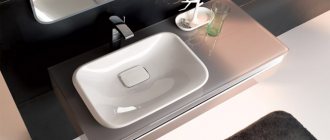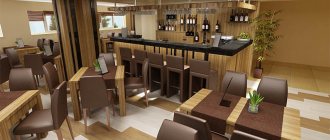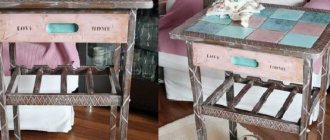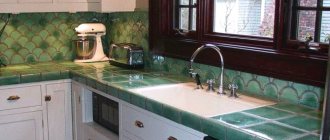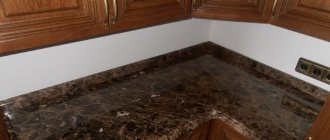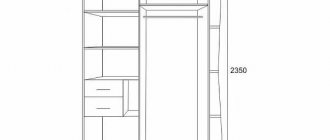353104
Arranging a kitchen space is not an easy task; it is necessary to arrange it so that it is functional and not cluttered. For this reason, when purchasing furniture for this room, it is worth considering its parameters. That is why the standard sizes of kitchen cabinets often coincide with the parameters of kitchens in typical high-rise buildings. But it is better to first measure the area of this room, height, length, depth, this will help you most accurately select the right set.
What you need to know to size kitchen cabinets
To calculate the appropriate dimensions for kitchen cabinets, it is necessary to take into account some features regarding this process. If you have not had to do this before, of course, you may encounter various difficulties.
For everything to work out, you need to do the work sequentially, namely:
- First, calculate the area of the room by taking general measurements;
- then study the size of the specific part of the kitchen where you will presumably install the set.
The size of the cabinets will be determined, first of all, by the requirements for them.
It is highly advisable during preparation to create a project for the future kitchen, while implementing it, for maximum accuracy, in some 3D editor. Since in this way it is possible to achieve an understanding of the spatial arrangement of cabinets as accurately as possible.
You can develop a drawing on a computer using one of the many design programs. A special article will tell you about the main nuances of making kitchen furniture drawings yourself.
Of course, in order to carry out this embodiment, you will have to hire professionals or ask people with specialized skills to help you. However, if you also have the skills you are looking for, then you will not need outside help.
It is important that in the end the kitchen looks as harmonious as possible
Corner kitchen
Corner cabinets appear in kitchens with corner layouts. They can be trapezoidal (most often they have a size of 900x900) or rectangular with an inaccessible part (here the sizes can be absolutely any).
The photo below shows an example of a corner kitchen with corner two-door cabinets. Here the cabinet size is 885x885, the size of the facades under the sink is 300 mm. Both facades open for easy access. The downside of such a cabinet is that it takes up a lot of space.
As for decorative elements, they are very much determined by the manufacturer. The most common are pilasters.
Their width varies from 50 mm to 150 mm (75 and 100 mm).
There are also decorative arches (or overlays) for open niches - their width is equal to the hood, that is, it is most often 600 and 900 mm (700 and 800 mm can be found).
The photo above shows the main elements of kitchen furniture. Here is an example of a kitchen in a classic style, in which there are decorative elements: pilasters, brailles (balusters), decorative overlay on the tabletop (pay attention to the end of the tabletop above the leftmost lower cabinet). Decorative elements vary greatly depending on the manufacturer. Their choice is largely determined by the machines and cutters that the manufacturer has.
Parameters of cabinets installed in the bottom row
When installing cabinets in the kitchen in the bottom row, it is necessary to clarify the parameters of the room. At the same time, the design style of the kitchen set can also play an important role, provided that the cabinets are equipped with non-standard decorative elements.
Dimensions to consider when developing a kitchen drawing
However, there are standard values that we have devoted this article to, and we now need to study them.
Table 1. Standard parameters of cabinets installed in the bottom row
| Parameter | Meaning |
| Total cabinet height | As a rule, the total height of downward-mounted cabinets is at least 85 centimeters. This height is enough to create enough space inside the furniture to store various dishes and other kitchen utensils. |
| Base height | The height of the plinth, or in other words, the height of the cabinets installed in the bottom row of the kitchen, from the flooring should usually be 10 centimeters. |
| Cabinet depth | The depth of the cabinets in our kitchen set, or rather its bottom row, has a standard value equal to 46 centimeters. So, if, for example, drawers are installed inside this cabinet, then:
|
| Tabletop width | The width of the tabletop, which is installed on cabinets and serves as our working surface, has three standardized sizes:
|
| Table top thickness | The thickness of the installed countertop can also be represented by several standard indicators, namely:
This parameter will directly affect the strength and cost of your kitchen furniture. Accordingly, the thicker, the stronger. |
| Tabletop overhang level | Indeed, you will have to evaluate such an indicator, even if you had not previously suspected it. So, the level of overhang of the tabletop can be:
If you take into account the availability of this reserve, you can safely place behind the cabinets such engineering and network elements as: |
| Front width | The width of the facades is another indicator that has several standard sizes. They will be as follows:
Since furniture is now quite often made to order, as a rule, the width of the cabinets, and with them the fronts, really varies. Please note: you should not install furniture with a facade width of more than 90 centimeters, since such a wide cabinet will cause serious inconvenience when using the piece of furniture. |
| Height of spaces between internal shelves of cabinets | This parameter is usually:
Everything will depend on what purpose this or that locker has. These parameters, although they are standard, are not at all mandatory, you should also take this into account. |
All parameters listed in the table above are closely related to each other. Moreover, on the basis of each of them others are built, therefore, it is important to strictly take into account the dimensions, since only this can help you maintain and increase the maximum functionality and convenience of the space allocated for cooking.
Even if you order furniture with dimensions that are unsuitable for your kitchen, you can “replay” this situation on your own. For example:
- replace too low twist-out legs with parts of greater height;
- basically remove the legs;
- replace a cabinet that is too wide with a narrower one, etc.
Some parameters of the furniture you purchase can be adjusted, for example, you can unscrew the legs and screw longer or shorter parts
Of course, in most cases, to make the above changes you will need to pay additional money on top of what you initially spent, so it is better to make the right calculations right away. Then the kitchen will still look as organic as possible.
The most suitable standard tabletop sizes
As for the most suitable standardized sizes, for example, countertops measuring at least 60 centimeters are considered the most popular. The fact is that making the work surface smaller is simply not profitable, since you will need space to cook. In addition, if you install a tabletop of the required size, you can easily subsequently select built-in appliances, for example:
- oven;
- dishwasher;
- hob, etc.
The countertop is the element of the kitchen set that requires special attention.
In general, ideally the countertop should be 90 centimeters in size , but this value is, of course, only suitable for large kitchen spaces. Although, there are also kitchens with countertops whose size is neither more nor less than 120 centimeters, however, we are, of course, talking about professional kitchens, or for those made in the loft style. Using such a large surface, you can even create an island in the middle of the eating or cooking area.
Dimensions of kitchen cabinets: nuances of space design
The organization of the kitchen space is influenced by many factors, taking into account which you can create the ideal kitchen in a specific environment and for a specific family. By following the rules of ergonomics, you can easily get a cozy and functional interior even in the smallest room. In order to properly organize the space, you need to decide on the issue of purchasing ready-made sets with standard modules, independently create a set of kitchen furniture from two rows of cabinets, or make a custom-made set.
First you need to take measurements of the room, measure the place where you plan to install the future kitchen set
Standard sizes of cabinets in mass production are used in furniture factories in order to save time and money. To create furniture based on individual measurements, parts are cut based on specific dimensions, which are produced by a specially trained measurer, taking into account the characteristics of the room, layout, stylistic design of the interior, as well as the taste preferences of the owners and their height.
If, in the case of purchasing a standard set, built-in appliances are purchased after the furniture is installed, then in individual projects you can start from the sizes of ovens, refrigerators and washing machines. As a result, the dimensions of kitchen cabinets should ensure convenient use, and their appearance should ensure the beauty of the interior.
The use of modular systems is the most economical solution in arranging kitchens. Sets of this type are assembled from ready-made cabinets with standard parameters.
Standard kitchen cabinet sizes and the working triangle rule
To properly organize the kitchen space, it is necessary to comply with the conditions of ergonomics, safety and convenience. The so-called working triangle rule will help to fulfill these requirements, which means that all components of furniture and appliances in the kitchen are placed in certain places. In this case, three main zones are taken into account:
- food preparation area, which includes part of the countertop, hob, microwave oven, multicooker, etc.;
- food storage place, including refrigerator, freezer, cereal cabinet, etc.;
- The cleanliness area combines the kitchen sink and dishwasher.
Helpful advice! When ordering modular kitchens, you must take into account that specific manufacturers set their own steps in the production of modules. It can be from 5 to 20 cm. For example, one factory produces modules for kitchens with a width of 45, 60 and 90 cm, while another uses cabinet size standards of 40, 80 and 120 cm in the creation of kitchen sets. This feature must be taken into account when calculating the total length work area and purchasing household appliances.
Following the listed ergonomic rules, all these three zones should be at a certain distance, creating a triangle. The ideal distance between work areas should be 120 cm, which is reflected in the dimensions of kitchen cabinets, drawings and kitchen designs.
It is not allowed to install a sink next to a stove or refrigerator. In this case, the equipment is subject to severe contamination, and for cooking, food must be constantly transferred through the sink on the way to the stove. Ideally, there will be space or part of the kitchen countertop between these three places. Here it is worth remembering the Feng Shui rule, according to which you cannot place sources of the elements of water and fire nearby.
Parameters of top-mounted cabinets
Wall kitchen cabinets also have their own standardized parameters. Knowing them, you can easily decide at what height to install the upper segment of the headset. Of course, calculations, as in the case of cabinets for the lower part of the kitchen, must be carried out in advance so as not to decide in the process which cabinet will go in which part of the room. Let's take a look at what standard features of external cabinets we need to know about.
Like the cabinets in the lower segment of the kitchen, the upper elements of the set have their own standardized sizes
Table 2. What are the standard sizes of kitchen wall cabinets?
| Parameter | Characteristics |
| Upper cabinet height | So, this parameter in the average value will be:
|
| Depth of wall cabinets | The standard depth for overhead cabinets is approximately 30 centimeters. Please note: if the kitchen had a large working surface, the depth of the cabinets should be no less than half of it. |
| Distance from apron to headset | The average distance of this gap is 45 centimeters. Of course, this indicator can vary in such a way as to suit the growth rates of the people using it. So, quite often it is increased to 55 and even 60 centimeters. |
| Front width | The average width of the facades of wall cabinets should coincide with the same value for the cabinets of the lower row. They will be as follows:
|
| Distance to wall-hung kitchen appliances | So, the standard distance, for example, from cabinets to the hood, should be about 70-75 centimeters if it is suspended above an electric stove, and 75-80 centimeters if it is suspended above a gas stove. |
| Permissible height of wall cabinets from the floor to the top end of the cabinet | So, this parameter on average will be about 210 centimeters. However, if you have installed a particularly tall cabinet in your home, then this parameter for it can be 2 meters 50 centimeters. |
Standard size of wall cabinets installed in the kitchen as furniture elements
Kitchen sets with the dimensions indicated in the tables we present are intended for use in the kitchen conditions of typical new buildings that are being built en masse today. It is important to remember that it is necessary to take into account not only the size of floor-mounted or hanging cabinets, but also the distance between these two types of cabinets.
If you don’t know what to put and where, how to place a set with everything you need in a small kitchen, we advise you to carefully study the special article and then apply the knowledge gained from it in practice.
The easiest way to plan a kitchen is to first calculate everything on the drawings
Optimal sizes
If, along with good lighting and sufficient working surface area, the set has a height suitable for the height of the owner, it can be considered comfortable.
It can be useful:
Types of kitchen countertops
Pros and cons of ceramic countertops for the kitchen
Plastic kitchen - advantages and disadvantages
The optimal ratio of the height of the kitchen countertop to the height of the hostess is presented in the table:
| Height | Tabletop level |
| Less than 150 cm | 76-82 cm |
| 160-180 cm | 88-91 cm |
| 180-200 cm | 100 |
It is equally important that there is enough space between the countertop and wall cabinets . If this distance is 45-60 cm, it will be convenient to remove dishes from wall cabinets and see the entire work surface. The optimal distance to a stationary hood is at least 70 cm.
Advice. You can check whether the tabletop is suitable in height even without measuring tools. You need to stand up straight, bend your elbow 90°, placing your forearm horizontally and your shoulder vertically. If, at the same time, the palm opened towards the floor just lies at the level of the tabletop, then its height is optimal relative to the height of the hostess.
Standard parameters of corner cabinets
In a room such as a kitchen, kitchen units are often installed, which occupy not one, but two walls of the room, even if each one is not from beginning to end. Thus, you have to play up the corner itself, installing there the most spacious of cabinets - corner ones.
Corner element
Prices for different types of corner sinks
Corner sink
Like other types of cabinets, this element of the kitchen set also has its own standard sizes. Let's look at them further in the table.
Table 3. Standard sizes of corner cabinets
| Parameter | Magnitude |
| Height | The floor-to-ceiling height of this cabinet must be standardized in order for the kitchen space to function as efficiently as possible. In this case we are talking about the level of cabinets:
|
| Depth | As we remember, depth is another important parameter. You need to define it for cabinets located both in the upper part of the set and in the lower part:
|
| Front width | This parameter is also very standardized, as, in fact, for all types of kitchens. It will be from 30 to 40 centimeters. |
| Table top thickness | The thickness of the countertop on the corner parts of the kitchen will be exactly the same as on other cabinets. Of course, as in all other cases, it is most appropriate to choose products characterized by the greatest possible thickness, especially when it comes to embedding a sink into it. |
| Distance from work surface | This parameter should not be less than 46 centimeters. |
Almost all kitchens installed today are corner ones.
As in the case of ordinary cabinets, you have the opportunity to select the size of a corner kitchen, guided not only by the parameters of the room, but also by your own desires. The most important thing is that you feel comfortable.
Location of kitchen cabinets and fronts: standard product sizes
The choice of size of kitchen cabinets is dictated by different conditions, in particular their location. Taking this feature into account, they are divided into the following types:
- wall or hanging;
- floor or lower;
- corner.
The main feature of wall-mounted kitchen cabinets is that they are attached to the wall, thus making up the second row of the set, which is why they are also called hanging, wall-mounted or top modules. The dimensions of wall-mounted kitchen cabinets are much smaller than floor-mounted ones. In addition, they should be lighter compared to the lower modules.
Floor cabinets are lower modules in the form of cabinets mounted on decorative or technical legs, which can be covered with a special base. Heavy and bulky items are usually stored in these cabinets, and household appliances are built into them. The depth of lower kitchen cabinets is on average 60 cm, and that of wall cabinets is 40 cm. When calculating the size of lower cabinets, be sure to take into account the parameters of the countertop.
Corner kitchen cabinets are designed to be placed in a corner, so they have the most complex structure. They are installed first and are the starting point for calculations and drawings and dimensions. Types of corner kitchen cabinets include top, bottom and tall models. Most often, a sink is installed in the corner at the bottom of the unit, and a cabinet with a dish dryer is installed at the top.
How to select the correct size of cabinets
The standard size of kitchen cabinets is therefore a standard because it was designed for use in standard kitchens. However, unfortunately, the premises in our new buildings are not built according to the standard at all; accordingly, even being called standard, they may have slightly different parameters. It turns out that cabinets need to be selected based on this risk. But it’s better not to take risks, but simply prepare by taking preliminary measurements of the kitchen.
The parameters of the kitchen set, even average ones, may not be suitable for your seemingly typical kitchen
So, the headset should fit into the room as accurately as possible. If, for example, a kitchen water heater is installed, then the pencil case for it needs to be built in so that it:
- did not clutter the room;
- fit in height.
Of course, if the furniture is selected for a kitchen that is decorated in a loft style, then, most likely, you don’t have to worry so much, since a loft does not imply the presence of small rooms at all. However, for all other kitchens, choosing furniture products is not so easy.
Loft style kitchen
Height detection
So, the optimal height of cabinets from the floor should be from 180 to 250 centimeters. At the same time, the height of the cabinets located below should be selected based on the height of the people using it. So, on average it will be about 85 centimeters. Therefore, when choosing a specific cabinet, try to immediately evaluate the dimensions of the products. They must necessarily match your height.
Ergonomics in the kitchen
The same should be done for the upper cabinets. Imagine that you hung them too high, while your height, so to speak, is small. As a result, it will be very inconvenient for you to get dishes and other kitchen kitsch from the upper, and sometimes lower, shelves.
Between the tabletop of the lower row of cabinets, as well as the lower end parts of the upper row, there should not be a distance exceeding a gap of 45 or 50 centimeters.
If you don’t guess with some sizes, then you yourself will subsequently find it inconvenient to cook in your own kitchen and, in principle, to be there
The total height of kitchen cabinets from floor to ceiling should not exceed 250 centimeters , since in this case the pieces of furniture we are interested in simply will not be included in either a standard or non-standard kitchen, with the only possible exception when it comes to on the design of space in a separate residential building.
Depth detection
Such an indicator as the depth of the cabinets is very important, since it is this that ensures the complete and most comfortable storage of the items you need in the kitchen, for example, sets of dishes and other utensils. Thus, it is recommended to increase the standard value of 20-40 centimeters, for example, to 50.
Today it is quite easy to make custom furniture, so you can move away from standardized norms in favor of less trivial solutions
However, if you want, you can also design cabinets of greater depth, the only thing is that in this case you need to make sure that they do not clutter the room.
Definition of width
Standard widths for kitchen cabinets may vary due to certain differences between these designs.
Table 4. Width of cabinets of various designs
| Description of design | Options |
| Single door lockers | This indicator of a single-leaf type of structure, the width normally ranges from 30 to 50 centimeters |
| Double door cabinets | For cabinets with two doors, the figure we are interested in will be approximately 60 to 100 centimeters |
| Corner designs | Corner cabinets, as a rule, are produced by themselves with a width of 90 centimeters. At the same time, however, the width of their facades is calculated according to the formula of isosceles triangles, which we have known since the time we studied geometry at school. So, in our case it will be equal to 130 centimeters. |
| Upper cabinet width | The width of the upper cabinets directly depends on the same indicator for the lower cabinets. So on average this figure ranges from 30 to 100 centimeters. |
| Facades of upper corner structures | An indicator such as the width calculated for the upper corner cabinets will be about 85 centimeters. |
Kitchen ergonomic rules
Kitchen height from floor to countertop: choose a multi-level option
Multi-level headsets are most convenient. They came into mass use not very long ago, but their demand is growing rapidly. The furniture impresses with its convenience, since all areas of the working area are at different levels. And this is very comfortable and correct. Let's consider each of these zones.
Surface for slicing and cutting
Here the products are cleaned and prepared for heat treatment. It is believed that it is most convenient to do this if everything you need is located at the level of the navel or slightly above. Therefore, the height of the cutting table is determined this way. It is important that its area is large enough, otherwise it will be uncomfortable to work. For the same reason, the sink is installed nearby.
When kneading foods, rolling out dough, etc. it is necessary to make significant efforts associated with pressure on the base. It will be much easier to do this if such an effort is directed from top to bottom. Thus, the plate for working with dough or kneading should be slightly lower than the one intended for cutting and cleaning. Its area may be small.
Instagram roda.kh.ua
It turns out that the ideal work area should be two-level. Most of it will be used to prepare food for cooking. The smaller one is for working with dough, etc. If the size of the room allows you to implement this option, it will be very convenient. Unfortunately, this is not possible in all kitchens.
Washing
Washing dishes, unless there is a dishwasher in the house, takes a lot of time and takes a lot of effort. To make the work as easy as possible, you need to choose a suitable location for the sink. This can be done using this method:
- We measure the distance from the bend of the elbow to the floor.
- We determine the height of the fist, that is, the distance between the little finger and the thumb in a compressed form. This is 11-13 cm.
- We subtract the second from the first and get the optimal sink height.
Instagram fashionstox_com
The results for each case will be different, but most find it convenient to place the sink slightly below the cutting and cleaning area. Even if this difference is small, it greatly facilitates the procedure of washing dishes and allows a person to take the most comfortable position.
Working triangle rule
Even cabinets of the most standardized sizes can be equipped in such a way that your kitchen becomes the most convenient and functional.
Of course, the cabinets themselves are not designed to store any specific items; here the approximate requirements or preferences are very conditional. So, we are talking about:
- storing large dishes, such as pots, in wide cabinets;
- storing cutlery and kitchen textiles, such as towels, in drawers;
- installation in a corner cabinet at the bottom of the trash can.
How the working triangle rule works on forges of different locations
However, today they not only put objects in cabinets, but also install built-in appliances that serve us as an assistant in cooking, washing dishes, etc. You also need to learn how to arrange it correctly so that the equipped kitchen is as ergonomic as possible.
Thus, an equipped kitchen should begin with the formation of a working area - a space in which the owner or mistress of the house will spend the greatest amount of time while cooking. It consists of:
- work surface, that is, an electric or gas hob built into a cabinet, or a stationary stove;
- food storage points or points, that is, refrigerator and freezer;
- cleaning zones - places where the sink and dishwasher are placed.
Don't forget that attention should also be paid to safety precautions.
From the photos presented in this section, you can see that the distance between each of these zones should be approximately equal to two arm lengths of the owners. The whole point is that:
- food is taken out of the refrigerator and carried to the sink;
- then you process them on the countertop;
- then carry it to the work surface to prepare the food;
- At the end of the process, the products are given time to cool, and then they are returned to the refrigerator.
This area needs to be designed correctly, preferably as close as possible to the cabinet in which spices, oils and other non-perishable ingredients for dishes will be stored.
You can choose the appropriate cabinet sizes individually
Keep in mind that it is also necessary to follow basic safety rules, that is, for example, do not place the sink near electrical appliances.
Prices for different types of kitchen cabinets
Kitchen wall cabinets
Arrangement of the workplace
The work triangle has three significant zones:
- Clean - the area around the sink where food is prepared for further cooking and dishes are washed. Sometimes there is a dishwasher.
- Food storage - adjacent to it is a refrigerator, a freezer, a rack with vegetables, and a place for storing cereals.
- Working plane - includes a hob, microwave oven, oven, countertop.
The location of the work triangle in different types of kitchens
The location of the zones is a basic factor in arranging a kitchen, since a refrigerator installed next to the sink will often get dirty. And the proximity of a stove and a sink will provoke a fire hazard. The maximum gap between the sink and the dishwasher is 90 cm. Read more
On a note! The optimal distance between one and another zone should not exceed 2 m.


